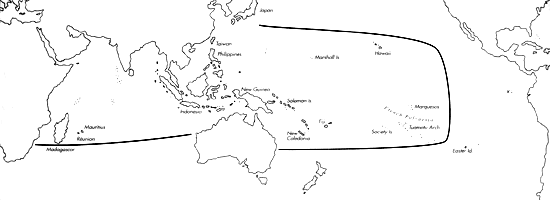Range: Entire Indo-Pacific, absent in Red Sea.
Description: Moderately large to large, solid to heavy. Last whorl conical or ventricosely conical, rarely broadly conical; outline almost straight at right side, convex at left side and concave at basal fourth. Subadult specimens often with slightly pyriform last whorl. Shoulder angulate, sometimes subangulate. Spire of low to moderate height, outline straight to slightly concave. Larval shell of 3 or more whorls, maximum diameter about 0.95 mm. Teleoconch sutural ramps flat to slightly concave in late whorls, with 2 increasing to 3-4 spiral grooves, obsolete in late whorls. Last whorl with widely spaced spiral ribs on basal third and a few spiral threads between; sculpture often obsolete in large specimens.
| Shell Morphometry | ||
|---|---|---|
| L | 50-132 mm | |
| RW | 0.51-1.50 g/mm | |
| (L 50-99 mm) | ||
| RD | 0.61-0.75 | |
| PMD | 0.81-0.91 | |
| RSH | 0.09-0.15 | |
Ground colour white. Last whorl with a variably broad dark brown spiral band above centre, also dark brown on basal fourth to third. Remaining areas clouded with lighter brown or olive, crossed by closely spaced to well separated, fine, brown to orange axial lines that extend to shoulder ramp. In New Caledonia, shells occasionally have almost the entire last whorl black. Larval whorls and adjacent sutural ramps pale yellow. Later sutural ramps white, with fine brown or orange axial lines partly overlying tan or olive blotches. Aperture translucent, even in large specimens.
Periostracum yellow to or greenish brown, thick, opaque and axially ridged, with widely spaced spiral rows of strong tufts on last whorl including shoulder edge; periostracum thinner, translucent and smooth in subadults.
Animal dark grey to greenish black or black. Foot stout, truncate at posterior end, with paler streaks and spots on dorsum. Siphon either of solid colour or mottled with white except for solid black distal edge (Pl. 75, Fig. 41) (Kohn, 1959a; Estival, 1981; Chaberman, pers. comm., 1981; Pearson, unpubl. observ.).
Radular teeth with an adapical barb opposite an incurved blade; pronounced serration of 10-25 pairs of small and large denticles extends about halfway down the shaft; base with a prominent spur (Peile, 1939; Zelazny, 1974; James, 1980).
Habitat and Habits: Intertidal, more common in upper subtidal to about 50 m; on intertidal benches and reefs, in bays, on slightly subtidal reef flats and in deeper subtidal habitats. In shallow water on sand or gravel among rocks, on beachrock, rough truncated reef limestone and lagoon pinnacles (Kohn, 1959 a, b, 1960, 1968; Kohn & Nybakken, 1975; Cernohorsky, 1964, 1978; Estival, 1981; Kilburn & Rippey, 1982; Grosch, pers. comm., 1989). C. miles feeds on eunicid, nereid and spionid polychaetes (Kohn, 1959b; Kohn & Nybakken, 1975; Reichelt & Kohn, 1985; Kilburn & Rippey, 1982). Spawning has been observed under rocks on reef flats, with egg capsules of 9.5 x 6 mm deposited in parallel rows (Cernohorsky, 1964; Loch, pers. comm., 1987). Egg diameter of 228 ┬Ám predicts a minimum pelagic period of 21 days (Perron & Kohn, 1985).
Discussion: C. miles has a very distinctive shell. It is readily distinguished from C. capitaneus, which lacks the pattern of fine brown or orange-brown axial lines over the last whorl and spire, and from C. vexillum vexillum, which differs in its lighter shell, more pronounced spiral sculpture on the late sutural ramps and its heavily blotched spire without fine radial lines; the spiral ground-colour bands on its last whorl are often narrower and irregularly edged or interrupted and sometimes obscured or absent.

C. miles range map
This section contains verbatim reproductions of the accounts of 316 species of Conus from the Indo-Pacific region, from Manual of the Living Conidae, by R÷ckel, Korn and Kohn (1995). They are reproduced with the kind permission of the present publisher, Conchbooks.
All plates and figures referred to in the text are also in R÷ckel, Korn & Kohn, 1995. Manual of the Living Conidae Vol. 1: Indo-Pacific Region.
The range maps have been modified so that each species account has it own map, rather than one map that showed the ranges of several species in the original work. This was necessary because each species account is on a separate page on the website and not confined to the order of accounts in the book.